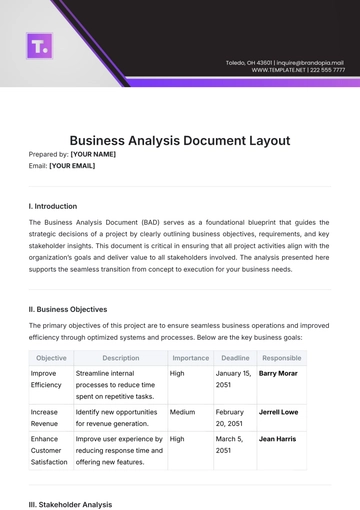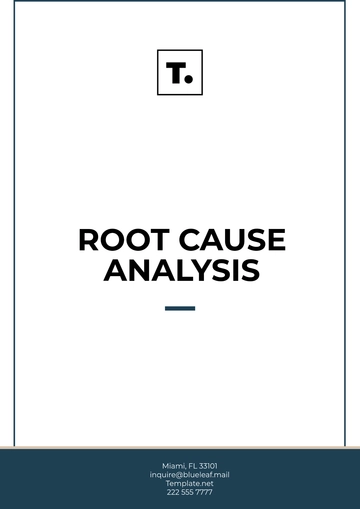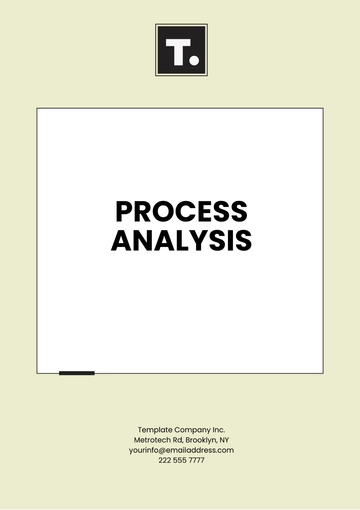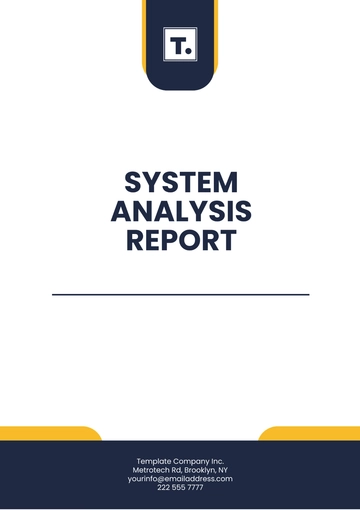Time Task Analysis
Prepared By | [Your Name] |
Company | [Your Company Name] |
Department | [Your Department] |
I. Introduction
A. Purpose
The purpose of this Time Task Analysis is to systematically examine how time is allocated and utilized within the Order Fulfillment Process. This analysis aims to identify areas for improvement in efficiency and productivity, ultimately leading to optimized performance and cost savings.
B. Scope
This analysis covers the Order Fulfillment Process, focusing on the Warehouse and Shipping Departments. The primary objective is to evaluate the time management of tasks such as order picking, packaging, and shipping preparation.
II. Methodology
A. Data Collection
Interviews: Structured interviews with 15 employees across different roles, including warehouse workers, shipping coordinators, and team leads. Interviews aimed to gather qualitative insights into time management challenges.
B. Analysis Techniques
Efficiency Analysis: Evaluation of task performance through key performance indicators (KPIs) such as task completion rate, error rate, and time variances. Identification of inefficiencies and bottlenecks impacting overall productivity.
III. Task Breakdown
Task ID | Task Description | Assigned To | Frequency | Average Duration (minutes) |
|---|
001 | Data Entry | [Employee] | Daily | 45 |
002 | Customer Support Calls | [Employee] | Hourly | 10 |
003 | Report Generation | [Employee] | Weekly | 120 |
004 | Inventory Check | [Employee] | Bi-weekly | 30 |
IV. Time Allocation
A. Time Spent on Tasks
Data Entry: 45 minutes per session, daily.
Customer Support Calls: 10 minutes per call, hourly.
Report Generation: 120 minutes per report, weekly.
Inventory Check: 30 minutes per check, bi-weekly.
B. Variations in Time Allocation
Data Entry: 40 - 50 minutes.
Customer Support Calls: 8 - 12 minutes.
Report Generation: 100 - 140 minutes.
Inventory Check: 25 - 35 minutes.
C. Detailed Time Allocation Table
Task Description | Min Duration (minutes) | Max Duration (minutes) | Average Duration (minutes) | Standard Deviation |
|---|
Data Entry | 40 | 50 | 45 | 3.5 |
Customer Support Calls | 8 | 12 | 10 | 1.2 |
Report Generation | 100 | 140 | 120 | 12.5 |
Inventory Check | 25 | 35 | 30 | 2.8 |
V. Efficiency Analysis
A. Performance Metrics
Completion Rate: 95% for data entry, 92% for customer support calls, 98% for report generation, and 100% for inventory checks.
Error Rate: 2% for data entry, 3% for customer support calls, 1% for report generation, and 0% for inventory checks.
B. Bottlenecks Identified
Data Entry (Task 001): Frequent interruptions cause inconsistent time allocation.
Customer Support Calls (Task 002): High volume during peak hours causing delays.
Report Generation (Task 003): Manual data compilation extending the time required.
Inventory Check (Task 004): Limited staffing during scheduled checks causing delays.
C. Efficiency Analysis Table
Task ID | Efficiency Issue | Impact | Suggested Solution |
|---|
001 | Frequent interruptions | Inconsistent time usage | Implement focus periods |
002 | High volume during peak hours | Delays in call handling | Increase staffing during peaks |
003 | Manual data compilation | Extended task duration | Automate data compilation |
004 | Limited staffing during checks | Delays in inventory check | Schedule additional personnel |
VI. Recommendations
A. Short-Term Actions
B. Long-Term Strategies
C. Resource Allocation
D. Implementation Timeline Table
Action | Responsible Party | Start Date | End Date | Status |
|---|
Improve Training | HR Department | [Start Date] | [End Date] | Not Started |
Optimize Scheduling | Operations Manager | [Start Date] | [End Date] | In Progress |
Implement Automation | IT Department | [Start Date] | [End Date] | Not Started |
Redesign Workflow | Process Improvement Team | [Start Date] | [End Date] | Not Started |
VII. Conclusion
A. Summary of Findings
The analysis reveals that while overall efficiency is high, specific tasks such as data entry and customer support calls experience significant inefficiencies due to interruptions and peak-hour volumes. Automation and improved scheduling are critical to addressing these issues.
B. Next Steps






























